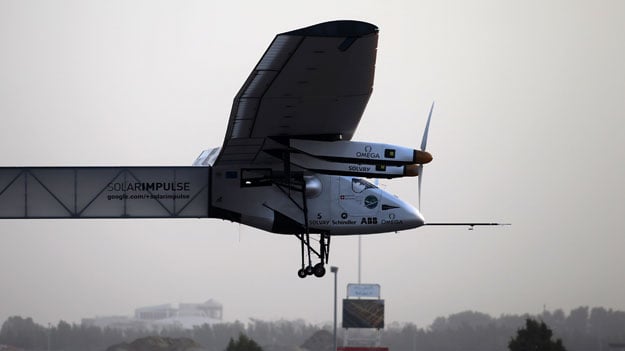
The Solar Impulse 2, piloted by Andre Borschberg of Switzerland, took off at 7:12 am local time from Al-Bateen airport and headed to Muscat, the capital of Oman, where it is expected to land later Monday after the first leg of the journey.

PHOTO: BBC
The takeoff, which was originally scheduled for Saturday but delayed due to high winds, capped 13 years of research and testing by Borschberg and fellow Swiss pilot Bertrand Piccard.
Two hours and 15 minutes into the flight, Borschberg was 13 percent of the way to Muscat and attempting to give media interviews before calling his wife, according to a website monitoring his progress.

PHOTO: AFP
Shortly before take-off, the 63-year-old pilot tweeted that the "challenge to come is real for me & the airplane".
"This project is a human project, it is a human challenge," Borschberg, co-founder and chief executive of the Solar Impulse project, told reporters on Sunday.
The wingspan of the one-seater plane, known as the Si2, is slightly bigger than that of a jumbo jet, but its weight is around that of a family car.

PHOTO: AFP
From Muscat, it will make 12 stops on an epic journey spread over five months, with a total flight time of around 25 days.
It will cross the Arabian Sea to India before heading on to Myanmar, China, Hawaii and New York.
Landings are also earmarked for the midwestern United States and either southern Europe or North Africa, depending on weather conditions.
The longest single leg will see a lone pilot fly non-stop for five days across the Pacific Ocean between Nanjing, China and Hawaii, a distance of 8,500 kilometres.
Borschberg and Piccard will alternate stints flying the plane, which can hold only one person, with the aircraft able to fly on autopilot during rest breaks.

PHOTO: AFP
The pilots have undergone intensive training in preparation for the trip, including in yoga and self-hypnosis, allowing them to sleep for periods as short as 20 minutes but awaken feeling refreshed.
All this will happen without burning a drop of fuel.
The pilots will be linked to a control centre in Monaco where 65 weathermen, air traffic controllers and engineers will be stationed. A team of 65 support staff will travel with the two pilots.

PHOTO: AFP
Should a problem occur while sleeping, the ground staff can wake up the pilot.
"We want to share our vision of a clean future," said Piccard, chairman of Solar Impulse, said of the mission.
"Climate change is a fantastic opportunity to bring in the market new green technologies that save energy, save natural resources of our planet, make profit, create jobs, and sustain growth."
The pilots' idea was ridiculed by the aviation industry when it was first unveiled.
But Piccard, a 57-year-old who hails from a family of scientist-adventurers and who in 1999 became the first person to circumnavigate the globe in a hot air balloon, clung to his belief that clean technology and renewable energy "can achieve the impossible".
The plane is powered by more than 17,000 solar cells built into wings that, at 72 metres, are longer than a jumbo and approaching that of an Airbus A380 superjumbo.
Thanks to an innovative design, the lightweight carbon fibre aircraft weighs only 2.3 tonnes, about the same as a family 4X4 and less than one percent of the weight of the A380.
The Si2 is the first solar-powered aircraft able to stay aloft for several days and nights.
The propeller craft has four 17.5 horsepower electric motors with rechargeable lithium batteries.
It will travel at 50-100 kilometres per hour, with the slower speeds at night to prevent the batteries from draining too quickly.
The Si2 is the successor to Solar Impulse, a smaller aircraft that notched up a 26-hour flight in 2010, proving its ability to store enough power in the batteries during the day to keep flying at night.
It made its last successful test flight in the United Arab Emirates on March 2, and mission chiefs reported no problems.
It is scheduled to arrive back in Abu Dhabi in July, flown by Piccard.
For him, "the project should not finish in July, it should start in July." A petition was launched at futureisclean.org to campaign in favour of clean energy.
Its progress can be monitored via live video streaming at www.solarimpulse.com.





1730884134-0/BeFunky-collage-(26)1730884134-0-270x192.webp)




1732618327-2/Untitled-design-(7)1732618327-2-270x192.webp)






COMMENTS
Comments are moderated and generally will be posted if they are on-topic and not abusive.
For more information, please see our Comments FAQ